Landscape gardens and greenhouses are dynamic spaces that bridge the gap between nature and human habitation. Lighting is a crucial element that enhances the aesthetics and extends the functionality and productivity of these environments. Proper lighting is critical in transforming an ordinary landscaped garden or greenhouse into an engaging and functional space. The interplay of light and shadow in these spaces can improve their aesthetics, safety, and productivity.
Landscaped gardens and greenhouses are cherished spaces where nature and architecture combine to create an oasis of beauty and tranquility. A well-designed landscape garden and a well-lighted greenhouse can elevate your outdoor living spaces, allowing you to enjoy the natural world at any time of the day or year.
In this guide, we will explore the art and science of landscape garden and greenhouse lighting, discussing various aspects such as the importance, advantages, disadvantages, types of lighting, the latest trends and innovations, and real-life garden and greenhouse lighting designs. From cutting-edge technology to design inspirations, you’ll discover how landscape garden and greenhouse lighting is evolving to transform outdoor spaces.
Landscape Garden and Greenhouse Lighting Definition. What is Landscape Garden and Greenhouse Lighting
Landscape garden and greenhouse lighting is the artful application of lighting fixtures to outdoor spaces, primarily gardens and greenhouses, to enhance aesthetics, safety, functionality, and productivity during evening hours. Outdoor garden and greenhouse lighting highlights specific areas, enables safe navigation after dark, increases productivity, and creates an alluring environment that extends outdoor area usability and transforms an ordinary garden and greenhouse into a delightful haven.

The Importance of Landscape Garden and Greenhouse Lighting Outdoor
In the realm of landscape gardening, the adage, “You never get a second chance to make a first impression,” holds. Proper lighting in your garden and greenhouse can instantly transform your property’s visual appeal. Well-placed lights can highlight the architectural features of your home, illuminate pathways, and showcase your carefully selected plants and trees. This not only makes your yard more appealing, but it also adds value to your home.
Your garden is not just for daytime enjoyment. Landscape lighting can extend the usability of your outdoor space well into the night. Whether you want to host evening gatherings, relax on your patio, or simply wander around your garden, the proper lighting can create a magical atmosphere that makes your garden an integral part of your lifestyle.
Landscape Garden and Greenhouse Lighting Advantages and Disadvantages
Gardens and greenhouses are engaging spaces that bridge the gap between the natural world and human habitation. One key element that plays a pivotal role in shaping these environments is lighting. Whether you’re adorning your garden with path lights or nurturing plants in a greenhouse, the usage of lighting has its advantages and disadvantages. This guide will explore the pros and cons of landscape garden and greenhouse lighting, helping you make informed decisions to illuminate your spaces while acknowledging potential challenges.
Landscape Garden Lighting Advantages
Enhanced Aesthetics: The most apparent benefit of landscape garden lighting is the aesthetic transformation it brings. Well-placed lights can highlight the beauty of your garden, turning it into an enchanting nocturnal fantasy. Path lights, uplights, and spotlights can accentuate your garden’s unique features, creating a visual spectacle.
Extended Usability: Landscape garden lighting extends the usability of your outdoor space into the evening. This means more time for relaxation, entertaining guests, or simply enjoying the serenity of your garden. Your garden becomes an outdoor living area, adding value to your property.
Safety and Security: Illuminating pathways and walkways with landscape garden lights not only adds charm but also enhances safety. Well-lit outdoor spaces reduce the risk of accidents and deter potential intruders, contributing to a sense of security.
Accentuating Focal Points: Landscape garden lighting allows you to draw attention to specific focus points, such as a spectacular tree, a lovely flower bed, or a work of art. This improves the visual appeal of your garden and gives depth to the environment.
Seasonal Adaptability: Landscape garden lighting can be customized for different seasons and events. You can switch from soft, warm lighting for cozy winter evenings to vibrant, colorful lights for festive occasions. This versatility adds to the charm of your garden.
Landscape Garden Lighting Disadvantages
Initial Cost: The installation of landscape garden lighting can be costly, especially if you opt for high-quality fixtures and professional installation. The initial investment may deter some homeowners from embracing outdoor lighting.
Energy Consumption: Landscape garden lights require electricity to operate, which increases energy consumption. Although energy-efficient LED lights minimize this issue, electricity bills can still rise if lights are left on for an extended period of time.
Maintenance: Outdoor lighting systems require routine maintenance to ensure they function correctly. Fixtures can become dirty, bulbs can burn out, and wires may get damaged over time. Ongoing maintenance can be a hassle for some homeowners.
Light Pollution: Poorly designed landscape garden lighting can contribute to light pollution, which affects your property and also disrupts nearby residences and the natural environment. It’s critical to design your lighting system to minimize light pollution.
Environmental Impact: The manufacturing and disposal of lighting fixtures and bulbs can have an environmental impact. Proper disposal of old bulbs, especially fluorescent and incandescent ones, is necessary to minimize the release of harmful substances.
Landscape Greenhouse Lighting Advantages
Year-Round Cultivation: Greenhouse lighting extends the growth season and allows for year-round cultivation. This means that you can grow a wide variety of plants, including delicate and exotic varieties, regardless of the external climate.
Precise Control: Landscape greenhouse lighting allows for precise control over light intensity and spectrum. LED grow lights, in particular, can be adjusted to provide the ideal lighting conditions for different plant species, growth stages, and seasonal changes.
Increased Yields: With the right lighting design, greenhouse growers can significantly increase crop yields. Consistent, optimized light conditions result in healthier, more productive plants, which yield a larger harvest.
Growth of Specialty Crops: Greenhouse lighting enables the cultivation of specialty crops that may not thrive in local outdoor conditions. This includes crops like tomatoes, cucumbers, and herbs, which are in high demand year-round.
Pest and Disease Control: Landscape greenhouse lighting can be used alongside pest and disease control measures. Light can deter certain pests, reducing the need for chemical treatments, and it can also help create an environment less conducive to fungal diseases.
Landscape Greenhouse Lighting Disadvantages
High Initial Investment: Setting up a greenhouse lighting system involves a significant initial investment. High-quality LED grow lights and the necessary infrastructure can be expensive. This cost can be a barrier for small-scale growers.
Energy Costs: Running greenhouse lights 24/7, especially in larger commercial operations, can lead to substantial energy costs. Greenhouse growers need to factor in electricity expenses when calculating the overall cost of production.
Heat Generation: Some lighting systems, such as high-intensity discharge (HID) lights, generate heat. While this is advantageous in cold conditions, it can lead to overheating issues in warmer regions. Effective cooling systems may be required, adding to operating costs.
Environmental Impact: The production of greenhouse lighting fixtures and the electricity used to power them contribute to environmental impact. Greenhouse growers need to consider the overall sustainability of their operations.
Complex Control Systems: Optimizing greenhouse lighting can be complex, particularly in large commercial greenhouses. Controlling multiple fixtures, adjusting light intensity and spectrum, and managing the interaction with natural light can be challenging.
Landscape Garden and Greenhouse Lighting Outdoor Types
In gardening and greenhouse cultivation, outdoor lighting is an art that transforms these spaces into enchanting and functional areas. Various types of lighting are used to achieve this, each serving a unique purpose. In this guide, we will explore the types of landscape garden and greenhouse lighting, including landscape garden and greenhouse ambient lighting, landscape garden and greenhouse task lighting, landscape garden and greenhouse accent lighting, and landscape garden and greenhouse decorative lighting. By understanding the characteristics and applications of each type, you can create captivating, well-lighted spaces that blend seamlessly with nature.
Landscape Garden and Greenhouse Ambient Lighting
Landscape garden and greenhouse ambient lighting serve as the foundational lighting for an outdoor space. It provides a soft, uniform glow that ensures safety and visibility in the absence of natural daylight. Ambient lighting sets the overall mood and creates a welcoming atmosphere.

Ambient lighting in gardens includes fixtures like pathway lights and wall-mounted fixtures. Pathway lights placed along walkways and trails provide a gentle, guiding glow. Wall-mounted fixtures are used to illuminate outdoor living areas, patios, and decks.
Ambient lighting within greenhouses is essential to guarantee sufficient visibility for activities like tending to plants, especially when confronted with overcast or dim weather conditions. This type of lighting usually works with pendant light fixtures designed to provide a consistent, mild glow across the entire greenhouse.
Landscape Garden and Greenhouse Task Lighting
Task lighting illuminates specific areas more brightly and precisely than ambient lighting. In gardens and greenhouses, task lighting is crucial for performing detailed activities that require additional light, such as reading or plant care.

Garden task lighting includes items like garden bed lights and outdoor work lights. Garden bed lights are installed near flower beds or shrubs to enable precise care and maintenance. Outdoor work lights are used in areas where gardening tasks require additional illumination, such as potting benches or workspaces.
In greenhouses, task lighting is necessary for activities like transplanting, pruning, or inspecting plant health. LED grow lights are a common choice, providing targeted, high-intensity light to specific plant zones.
Landscape Garden and Greenhouse Accent Lighting
Landscape garden and greenhouse accent lighting is used to draw attention to particular features or elements within the outdoor space. It adds drama and visual interest by creating focal points and highlighting the beauty of key landscape elements.
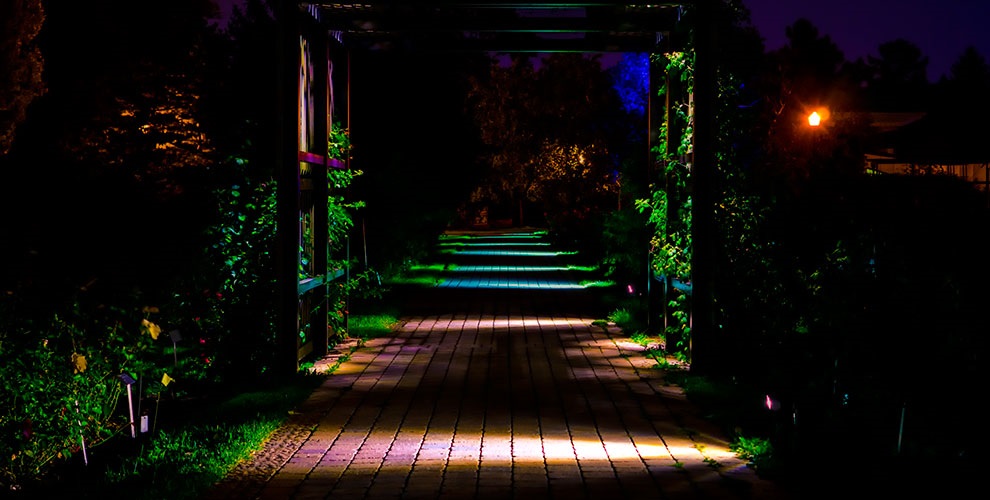
Accent lighting in landscape gardens includes fixtures like uplights and well lights. Uplights are installed at the base of trees or sculptures to cast light upwards, creating dramatic silhouettes. Well lights are positioned in the ground to highlight architectural elements, like columns.
While accent lighting is less common in greenhouses, it may be used to highlight exceptional or unique plant specimens. It can create a visually pleasing effect and draw attention to specific areas of interest.
Landscape Garden and Greenhouse Decorative Lighting
Landscape garden and greenhouse decorative lighting serves both aesthetic and functional purposes. It adds a touch of style and creativity to outdoor spaces while still providing lighting. Decorative lighting fixtures are visually pleasing and blend into the overall design.

Garden decorative lighting comprises fixtures like string lights, lanterns, and sconces. String lights can create a cozy and enchanting atmosphere, perfect for outdoor gatherings. Lanterns and sconces enhance the charm of outdoor living spaces and pathways.
Decorative lighting is less common in greenhouses due to the emphasis on functionality. However, in educational or research greenhouses, decorative fixtures can offer a touch of artistry while providing adequate lighting.
Landscape Garden & Greenhouse Lighting Outdoor Fixtures
The sci-art of landscape garden and greenhouse lighting transforms outdoor spaces into enchanting realms of natural beauty and productivity. To accomplish this, a wide range of lighting fixtures are available, each intended for unique uses and aesthetics. This tutorial will look at different types of outdoor lighting fixtures designed for gardens and greenhouses. From LED lights to solar lights, each fixture serves a unique function. By understanding the characteristics and applications of these lighting fixtures, you can create captivating, well-lighted spaces that enhance the beauty and functionality of the outdoor environment.
Garden & Greenhouse LED Lights
Light-emitting diode lights are energy-efficient fixtures that provide bright, focused lighting. LED lights are popular in gardens and greenhouses because of their low energy consumption, long lifespan, and versatility. LED lights offer a range of color options, allowing for customized lighting effects.

LED lights for gardens and greenhouses can light up garden pathways and walkways, emphasize certain plants or garden features, and provide energy-efficient lighting for outdoor living spaces.
In greenhouses, LED lights are essential for providing precise light spectrums for plant growth, maximizing energy efficiency and minimizing heat generation, extending the growing season, and supporting year-round cultivation.
Garden & Greenhouse Pendant Lights
Pendant lights are suspended fixtures that hang from a ceiling or structure. They provide focused downward lighting and are often selected for their practical and aesthetic value.

Garden and greenhouse pendant lights can illuminate dining and seating areas in outdoor gardens and add a decorative touch to pathways or garden features.
In greenhouses, pendant lights are typically used in educational or research areas to provide functional lighting with a stylish aesthetic. They can also be used for specialized plant care.
Garden & Greenhouse Post Lights
Post lights are fixtures installed on posts or pedestals to give low-level, ambient lighting along walkways and garden borders.

Garden and greenhouse post lights are used to define boundaries and perimeters, illuminate paths and walkways, and create a warm and welcoming environment.
Post lights are not commonly used in greenhouses, as their low-level ambient lighting is better suited for landscape gardens.
Garden & Greenhouse Railing Lights

Railing lights are fixtures designed to be installed on handrails or railings. They provide a soft, discreet glow, enhancing safety and aesthetics. Garden and greenhouse railing lights illuminate decks in outdoor living spaces and offer a decorative touch to garden and greenhouse paths.
Garden & Greenhouse Solar Lights
Solar lights collect and store solar energy during the day in built-in batteries. They are a sustainable and energy-efficient option that does not require any electrical wiring.

Garden and greenhouse solar lights can illuminate paths, outdoor living spaces, and garden beds, and create a sustainable and energy-efficient garden lighting solution.
Solar lights can be used in greenhouse areas with direct sunshine, such as greenhouse entrances or outdoor educational spaces. However, their application inside the greenhouse is limited due to the need for consistent lighting for plant growth.
Garden & Greenhouse Strip Lights
Strip lights, also known as LED strips, consist of a flexible strip with embedded LED diodes. They are versatile, energy-efficient, and customizable in length.
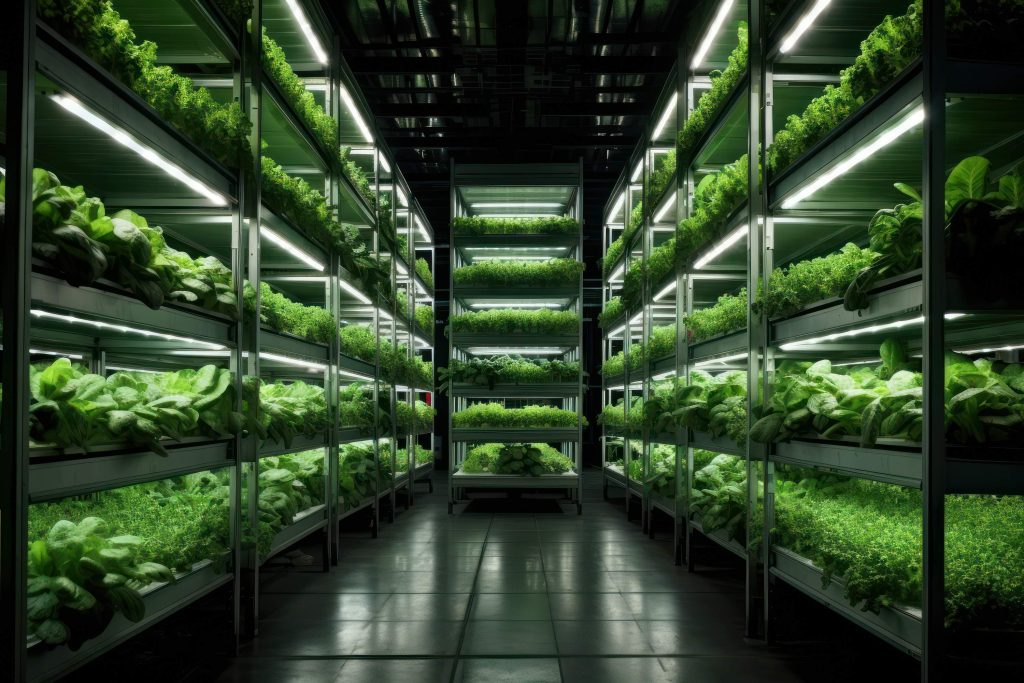
Garden and greenhouse strip lights are used for under-cabinet or under-railing lighting for a modern and sleek look, illuminating landscape items like water features or garden sculptures and creating customized lighting effects in outdoor spaces.
In greenhouses, strip lights are versatile tools for supplemental lighting in specific areas that require additional illumination, such as plant propagation tables or workspace areas.
Garden & Greenhouse String Lights
String lights consist of multiple small bulbs connected by a string or wire. They are renowned for their ability to create a charming and festive atmosphere.
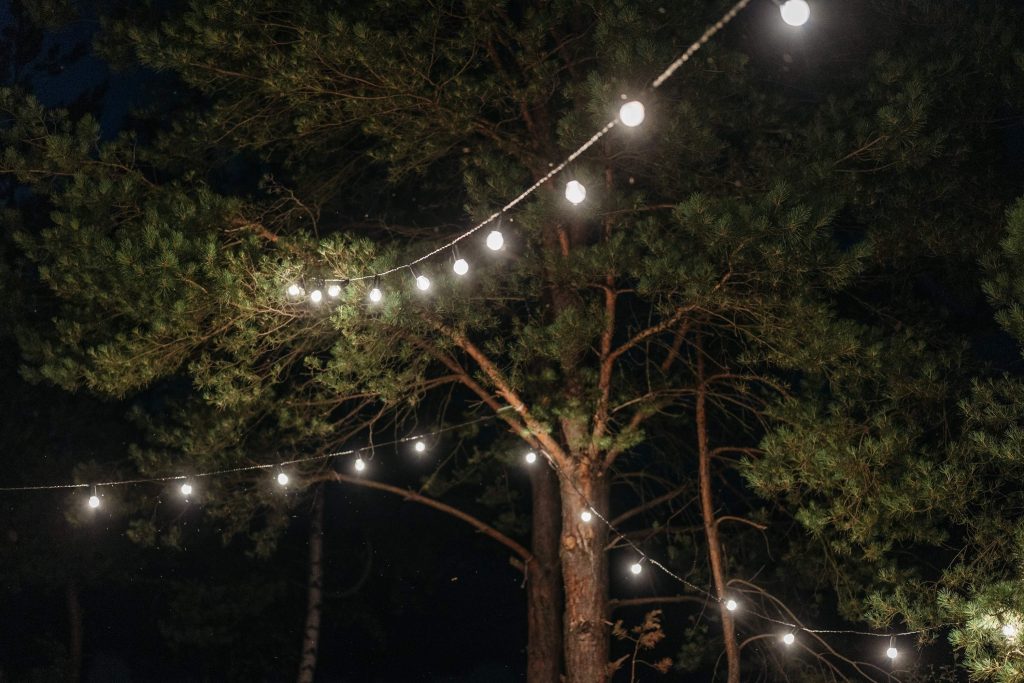
Garden and greenhouse string lights are used to adorn outdoor recreational areas such as patios and gazebos, as well as to create a festive mood for special events and celebrations.
String lights frequently appear in greenhouse spaces for instructional or event purposes. They can create a festive ambiance for workshops, classes, or gatherings held within the greenhouse.
Garden & Greenhouse Step & Stair Lights
Outdoor step and stair lights are designed for safety, illuminating stairs and steps to prevent accidents. They are low-profile fixtures with a focus on functionality.

Garden and greenhouse step and stair lights are used for safe navigation, lighting outdoor staircases, steps, and pathways, and adding discreet and practical lighting to garden structures and outdoor amenities.
Step and stair lighting can be used in greenhouse entryways or areas with elevated platforms where safety lighting is needed.
Garden & Greenhouse Wall Lights
Wall lights, often known as wall sconces, are lighting fixtures designed to be installed on vertical surfaces. They provide both functional lighting and decorative charm.

Garden and greenhouse wall lights are used to illuminate outdoor living spaces such as porches and patios, as well as to add elegance to garden walls, façades, or architectural features.
Wall lights can be used in greenhouse entryways, near workstations, and in educational greenhouse spaces where both functionality and aesthetics are vital.
Guide to Installing Outdoor Landscape Garden and Greenhouse Lighting
Gardens and greenhouses are enchanting spaces that bridge the gap between the natural world and human habitation. The art of lighting can transform these outdoor environments into captivating, well-lighted realms of beauty and functionality. This guide will delve into the step-by-step procedure of installing outdoor landscape garden and greenhouse lighting. From the initial planning and design to the final fine-tuning, we’ll explore each phase to ensure that your outdoor spaces are not only well-lit but also seamlessly blend with nature.
Plan and Design
Take the time to study the landscape before going on the installation adventure. Determine the essential features, plants, trees, and structures you want to emphasize with lighting. Determine whether locations need lighting for safety, aesthetics, or functionality. Define your lighting goals. Do you want to create a cozy atmosphere in a garden seating area, highlight a magnificent tree, or provide task lighting in the greenhouse? Knowing your objectives is essential for the design phase.
Consider the various types of lighting, including ambient, task, accent, and decorative lighting. Each type serves a unique purpose and should be incorporated strategically to meet your goals. Determine the placement of fixtures based on your design plan. Take into account the fixtures’ size, style, and intended purpose. Check that the fixtures are rated for outdoor usage and can withstand the local weather.
Plan the cable layout that connects the fixtures. Opt for durable, weather-resistant cables designed for outdoor use. Measure the distances between fixtures to determine cable lengths.
Gather Materials
Compile a checklist of materials you’ll need for the installation, including lighting fixtures, cables, transformers, wiring, connectors, mounting hardware, and any specialized tools.
Choose lighting fixtures that align with your design objectives. Select fixtures that blend with the landscape’s aesthetics while fulfilling your lighting requirements.
Select an appropriate transformer to convert household voltage to the low voltage required for landscape lighting. Ensure it has sufficient capacity to power all the fixtures.
Install Fixtures and Lay the Cables
Start by placing the fixtures in their designated locations. Follow your design plan and ensure that the fixtures are securely installed. In gardens, consider path lights, well lights, and wall-mounted fixtures. In greenhouses, place fixtures where they provide optimal light coverage.
Lay the cables along the planned route, connecting the fixtures. Buried cables are recommended for a neat and discreet installation. To avoid damage, ensure that cables are adequately protected and concealed.
Install the transformer near a power source and keep it out of the elements. Connect the primary and secondary wiring following the manufacturer’s instructions.
Connect Wiring and Transformer
Connect the cables to each fixture as you go along. Use waterproof connectors to ensure a secure and weather-resistant connection. Pay attention to the polarity to ensure fixtures function correctly.
Connect the low-voltage wiring from the lighting fixtures to the transformer’s secondary output. Use wire nuts or waterproof connectors to secure the connections. Ensure that the wiring is properly insulated.
Configure the transformer settings, including the operating schedule. Timers or light-sensitive sensors can be added to automate the lighting system, turning it on and off at designated times. Connect the transformer to the domestic power supply. Check that the power source is properly grounded and that the electrical circuit is safe.
Always prioritize safety. Install ground fault circuit interrupters (GFCIs) to protect against electrical shock. Keep all wiring and connections well-protected from moisture.
Test the System
Perform an initial test of the lighting system before burying wires or finishing the installation. Examine each fixture to confirm that it lights as expected and that the cables and connections are in good working order.
Fine-tune the angles of fixtures as needed to achieve the desired lighting effects. Ensure that fixtures are properly oriented to emphasize specific landscape components or to establish safe routes.
Test the functionality of any timers or light-sensitive sensors you’ve included. Check that the system responds to variations in daylight or turns on and off according to your lighting schedule.
Fine-Tuning
Walk through your landscape garden and greenhouse to make final adjustments. Ensure that the fixtures are in their ideal positions to create the intended lighting effects. Verify that the lighting system does not produce excessive glare. Adjust fixture angles and shielding if glare is an issue.
If your lighting system includes multiple fixtures, consider the energy efficiency. Ensure that you’re using LED or energy-efficient bulbs to reduce energy consumption. Discuss a maintenance schedule and routine with garden or greenhouse personnel. Proper maintenance ensures that fixtures stay clean, functional, and long-lasting.
Landscape Garden and Greenhouse Lighting Outdoor Best Practices
Gardens and greenhouses are displays of nature’s beauty and human ingenuity. The art of lighting can elevate these outdoor spaces, transforming them into enchanting realms of splendor, functionality, and productivity. This guide will explore the best practices for landscape garden and greenhouse lighting, delving into design ideas, how to avoid common mistakes, tips for maintenance and troubleshooting, and the latest trends and innovations. Following these best practices will guarantee that your outdoor spaces are not only well-lit but also integrate with nature.
Design Ideas for Landscape Garden and Greenhouse Lighting
The beauty of gardens and greenhouses resides in their capacity to combine nature and human invention. Lighting bridges the gap between the wonder of these outdoor places, transforming them into mesmerizing areas of beauty and functionality. From combining light and heat to imitating natural sunlight, we’ll look at how to light your outdoor spaces in ways that blend in with nature.
Combining Light and Heat
Fire features, such as fire pits, fireplaces, or torches, are functional and visually pleasing. They add a touch of warmth and ambiance to your garden or greenhouse, making them inviting places to relax and enjoy. Combining fire with lighting creates a harmonious blend of light and heat, making your outdoor space comfy even on cool evenings.
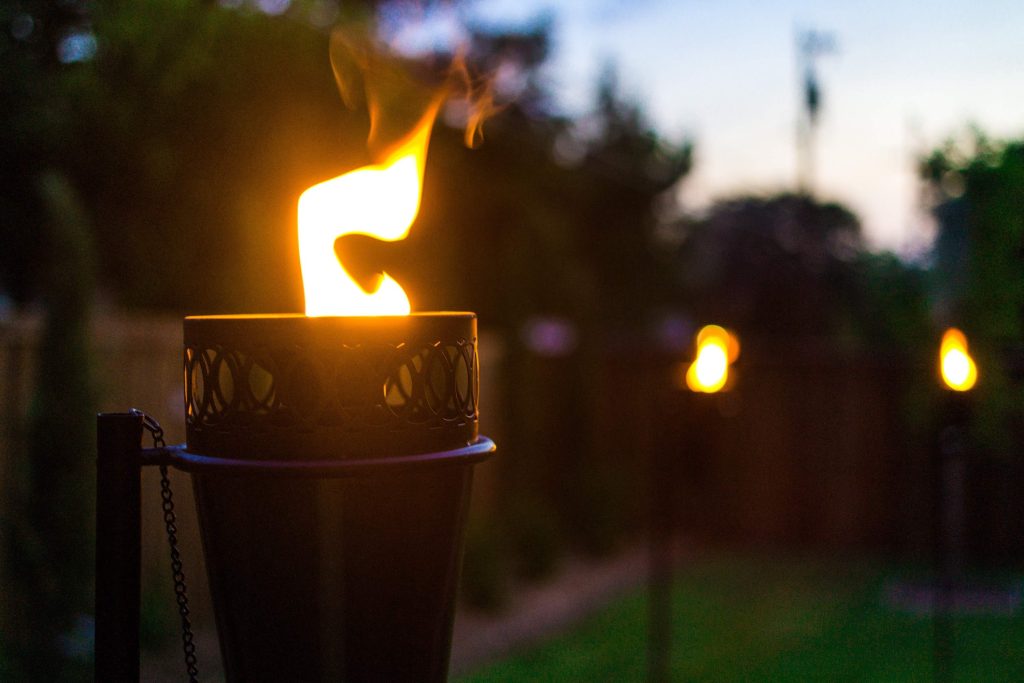
For greenhouses in cooler climates, consider using heated planters or mats. These provide warmth to your plants and serve as an additional source of soft, gentle lighting. The combination of light and heat is particularly beneficial for nurturing tropical or heat-loving plants in your greenhouse.
Highlighting Plants and Trees
Uplighting is a technique that involves positioning fixtures at the base of trees and directing light upward. This method highlights the beautiful structure of trees and adds a sense of depth and drama to your garden. Up-lighting is especially effective for showcasing tall or unique trees that deserve attention.
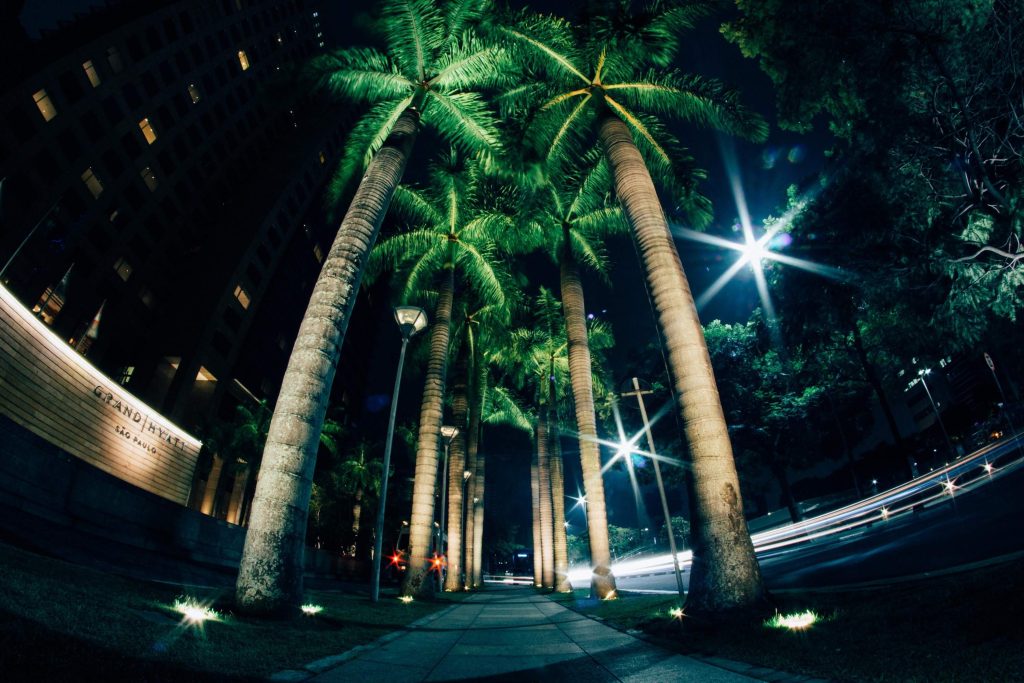
Silhouetting is achieved by placing a light source behind a plant or shrub. The plant’s silhouette is cast against a wall or background, creating a stunning visual effect. This technique works well with plants that have interesting shapes or textures, turning them into natural works of art.
Path lights serve the dual purpose of enhancing safety and highlighting the path itself. They create a sense of direction and lead the way through your garden or greenhouse. Use fixtures that emit a soft, warm glow to create a welcoming atmosphere.
Moonlighting Garden
To mimic the magical effect of moonlight, place light fixtures high up in trees and aim them downward. The soft, diffused light creates a dreamy ambiance in your garden or greenhouse, enhancing the enchanting qualities of the night. Use low-wattage or warm LED bulbs to achieve the desired effect.

Moonlighting not only provides soft illumination but also casts beautiful shadows. The interplay of light and shadow adds an extra layer of visual interest to your outdoor space. Consider placing fixtures in trees with intricate branches or near garden features to enhance the shadow play.
Simulating Natural Sunlight
Greenhouses rely on sunlight for plant growth, and simulating natural sunlight is essential for year-round cultivation. Full-spectrum lighting, such as T5 or LED grow lights, provides the ideal spectrum of light that plants require. You can manage the light cycle and assure optimal growth by utilizing these lights.

Install light control systems that adjust the intensity and duration of artificial lighting in your greenhouse. Automation allows you to create lighting schedules that mimic the changing light conditions of each season, optimizing plant health and productivity.
Uplighting Artwork and Sculptures
Art and sculptures can add a unique dimension to your landscape. Uplighting these features provides a stunning showcase during the evening. Well-placed fixtures can highlight the textures, details, and beauty of your garden art, turning them into focal points of your outdoor space.

The angle and intensity of uplighting can create different effects. Subtle uplighting can gently emphasize the details of sculptures, while dramatic uplighting can create striking contrasts and add a touch of theatricality to your garden or greenhouse.
Vertical Gardening Vegetables
Vertical gardening is a creative and space-saving way to grow vegetables in a greenhouse. Vegetables can be grown vertically using trellises, hanging baskets, or wall-mounted planters. Lighting these vertical gardens with LED or fluorescent fixtures ensures that all plants receive adequate light, leading to healthier and more productive crops.

Consider employing fixtures with adjustable light intensity to meet the varying lighting requirements of diverse vegetable plants. This lets you customize the amount of light for each crop, whether it’s leafy greens, tomatoes, or herbs.
Avoiding Common Mistakes in Landscape Garden and Greenhouse Lighting
Over-Illumination: One common mistake is over-illumination. Excessive or overly bright lighting can wash out the natural beauty of your landscape and cause light pollution. Avoid this by selecting fixtures with the appropriate brightness for each area.
Poor Fixture Placement: Fixtures should be installed thoughtfully to avoid glaring or harsh lighting. Improper placement can lead to uneven illumination, shadowy spots, and discomfort for the observer. Pay attention to the fixture’s angle and direction.
Neglecting Energy Efficiency: Failing to prioritize energy-efficient lighting can result in higher energy bills and increased carbon footprint. Opt for LED or solar-powered fixtures to reduce energy consumption and environmental impact.
Lack of Maintenance: Neglecting maintenance can lead to fixture failures, reduced performance, and safety issues. Regularly clean fixtures, check connections and replace bulbs or LEDs as needed to keep your lighting system in optimal condition.
Maintenance and Troubleshooting Tips
Fixtures and lenses can become clogged with dust, grime, and debris, limiting their efficacy. Clean fixtures periodically to ensure they emit the intended illumination. Be gentle to avoid damaging the fixtures.
Over time, bulbs or LEDs may wear out, resulting in diminished light quality. Regularly replace these components to ensure consistent, high-quality lighting.
Outdoor fixtures are exposed to the elements, making them susceptible to water damage. Inspect fixtures for signs of water ingress and replace any damaged components to prevent electrical hazards.
Loose wiring or connections can cause flickering lights or complete outages. Inspect wiring and connectors, tightening them as necessary to maintain a secure electrical connection.
Outdoor lighting fixtures can attract insects or become homes for pests. Use protective covers or consider insect-repelling lighting options to deter unwanted visitors.
Trends and Innovations in Landscape Garden and Greenhouse Lighting
Gardens and greenhouses are places where the splendor of nature meets human ingenuity. Lighting serves as a transformative tool, enhancing the enchantment of these outdoor spaces. In this tutorial, we will look at the latest trends and advancements in landscape garden and greenhouse lighting. From biophilic lighting design to smart control and quantum sensors, these advances take outdoor lighting to new heights while seamlessly blending in with the natural world.
Biophilic Lighting Design
Biophilic lighting design is a novel approach that mimics patterns, colors, and characteristics of natural light. This trend acknowledges the profound impact of nature on our well-being and strives to replicate the essence of outdoor lighting indoors. Biophilic lighting design in the garden and greenhouse can extend the natural atmosphere into the evening, creating an ideal blend of both worlds.

Biophilic lighting prioritizes natural color temperatures that align with the outdoor environment. Warm, inviting tones during the evening and cooler, energizing hues during the daytime help create a serene yet dynamic atmosphere. LED fixtures with adjustable color temperatures can replicate the changing qualities of sunlight to cater to different moods and activities.
Adjustable Light Intensity
Adjustable light intensity allows you to tailor the lighting to specific areas and activities. LED fixtures equipped with dimming capabilities can create a cozy ambiance for outdoor dining, provide bright lighting for gardening tasks, or offer gentle night lighting. This flexibility enhances both functionality and aesthetics in your garden and greenhouse.
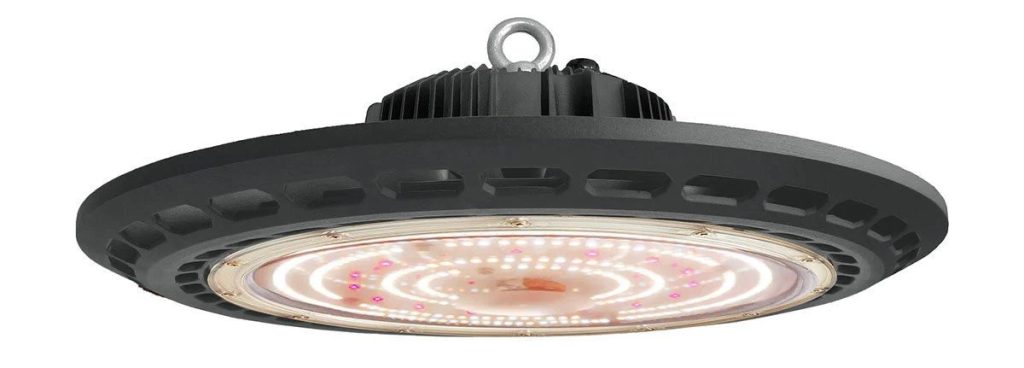
The ability to adjust light intensity is highly beneficial in greenhouses, where different plants may have varying light requirements. For instance, vegetables, herbs, or flowering plants may benefit from varying degrees of illumination at different growth stages. Fine-tuning the light intensity optimizes growth and yield.
Light Spectrum Optimization
Full-spectrum LED lighting is a cutting-edge innovation that provides a balanced and full spectrum of light, similar to natural sunlight. This technology offers optimal conditions for plant growth in greenhouses. It permits year-round cultivation and supports healthy and vigorous plants by providing all the necessary wavelengths for photosynthesis.
Spectrum tuning allows you to customize the light spectrum based on the specific needs of your plants. This technology enables you to stimulate different growth phases, enhance flowering, or precise plant health management. By fine-tuning the light spectrum, you can maximize the growth potential of your greenhouse crops.
Landscape Garden and Greenhouse Lighting LED
LED lighting continues to dominate the garden and greenhouse lighting industry. LED fixtures offer remarkable energy efficiency, long lifespans, and excellent color rendering. This technology saves energy and has a lower environmental impact, making it an ecologically friendly option for lighting outdoor areas.

LED lighting fixtures are low-maintenance, requiring fewer bulb replacements and less upkeep. This feature is particularly beneficial in the garden and greenhouse, where routine maintenance can be a challenge. LED fixtures reduce the hassle of frequent bulb changes and keep your outdoor spaces well-lighted with minimal effort.
Landscape Garden and Greenhouse Lighting Solar-Powered
Solar-powered lighting fixtures represent a sustainable approach to outdoor illumination. These fixtures collect solar energy throughout the day and store it for use at night. They drastically reduce energy expenses, minimize your carbon footprint, and help to make the environment greener.

Solar-powered fixtures are versatile and easy to install, making them ideal for remote or off-grid areas of your garden or greenhouse. You can position them where needed without worrying about wiring or power sources. These fixtures can create welcome walks or highlight specific garden elements.
Landscape Garden and Greenhouse Lighting with Smart Control
Smart control systems take garden and greenhouse lighting to new heights. You can adjust the brightness, color, and scheduling of your lights with smartphones or voice-activated devices. This technology enables you to create custom lighting scenarios, automate the lighting based on time or conditions, and even monitor your lighting system remotely.

Smart control systems allow you to fine-tune your lighting, reducing energy consumption. By setting up schedules, motion sensors, or light-sensitive sensors, you can ensure that your outdoor lighting functions only when needed, thus conserving energy and lowering utility costs.
Landscape Garden and Greenhouse Lighting with Quantum Sensors
Quantum sensors are an innovative solution for achieving precise and efficient lighting in greenhouses. These sensors measure the light intensity and spectrum within the greenhouse, allowing you to maintain the ideal conditions for plant growth. Quantum sensors give real-time data on light levels, allowing you to adjust artificial lighting to match the sunshine and ensure that your plants receive the proper quantity of light.

By incorporating quantum sensors, you can optimize the light exposure for different plants at various growth stages. This technology ensures that your greenhouse crops receive the ideal light conditions, resulting in enhanced growth, higher yields, and better crop quality.
Real-Life Landscape Garden and Greenhouse Lighting Outdoor Designs
The beauty of gardens and greenhouses lies in their unique ability to blend nature’s magnificence with human artistry. Landscape garden and greenhouse lighting is a transformative tool that enhances outdoor spaces, creating an atmosphere of enchantment and functionality. This tutorial will look at actual landscape garden and greenhouse lighting designs. We’ll explore unique outdoor lighting ideas that effortlessly combine with the natural world, from artistry in bloom to modern integrated greenhouses, smart greenhouse control, and vertical farming solutions.
Artistry in Bloom
The colorful splendor of garden flowers is celebrated in the Artistry in Bloom lighting design. Low-voltage LED lamps are strategically placed among the flowerbeds to achieve this effect. By using warm, gentle light, they create a soft, welcoming atmosphere that showcases the intricate details of each blossom. The interplay of light and shadow enhances the garden’s visual appeal, turning it into a living masterpiece.

Incorporate path lights and uplighting to guide visitors through the garden. Well-lit pathways not only enhance safety but also add a sense of enchantment. Furthermore, focus lighting on garden focal points, such as water features, sculptures, or architectural elements, to draw the eye and create an artistic balance in the garden.
Modern Integrated Greenhouse
Modern integrated greenhouses are designed to grow plants all year round. A full-spectrum LED fixture combination is used to create excellent lighting conditions. These fixtures imitate natural sunshine, ensuring that plants receive the light spectrum they require for growth. The architecture of the greenhouse allows for controlled ventilation, temperature, and humidity, which improves plant health and productivity.
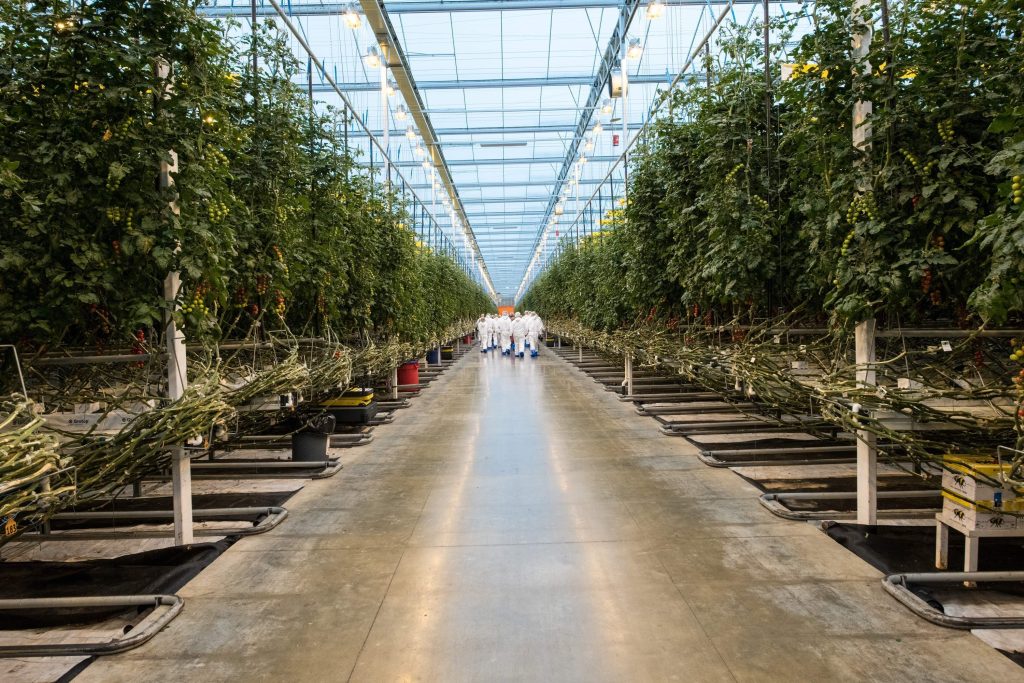
Additional lighting is essential in locations with inadequate sunlight, particularly during the winter months. LED grow lights are placed above the plants for precise and uniform lighting. Growers can alter light intensity and spectrum based on plant growth phases and crop needs by using smart lighting control systems.
Smart Greenhouse Control
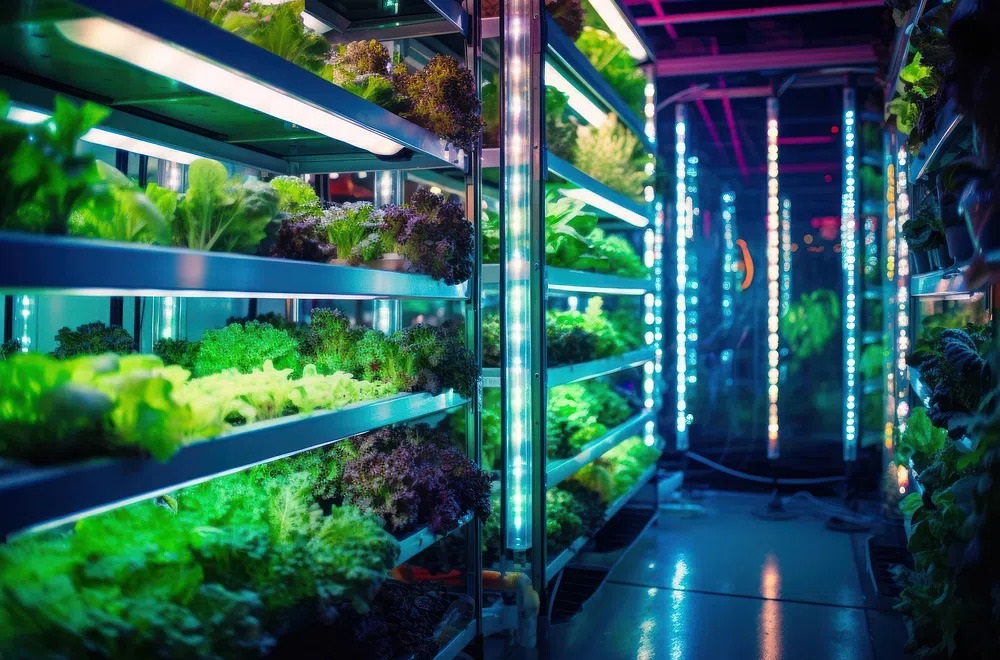
Smart greenhouse control systems have revolutionized the way we manage lighting. Sensors in these systems monitor natural light levels and adjust artificial lighting accordingly. The result is a dynamic lighting system that complements natural sunlight, reducing energy consumption and ensuring plants receive the ideal light intensity. Growers may fine-tune their lighting with smart control to enhance energy savings. The use of light sensors and timers guarantees that the lights only work when they are needed.
Vertical Farming Solutions
Vertical farming has become an innovative solution for maximizing crop yield in limited space. These designs employ vertical shelves or towers to grow a variety of crops. Lighting is a critical component, with LED fixtures providing the necessary illumination for plants. The design allows for efficient space utilization, making it suitable for urban agriculture or greenhouse environments.

In vertical farming, different crops often share the same space. Spectrum-tailored lighting is used to meet the specific needs of each plant. This approach involves adjusting the light spectrum based on the crop type, growth stage, and desired outcomes. By customizing the spectrum, growers can enhance productivity and crop quality.
Conclusions
As we conclude our exploration of landscape garden and greenhouse lighting, it’s clear that the journey has just begun. Biophilic lighting design, adjustable light intensity, light spectrum optimization, LED and solar-powered fixtures, smart control systems, and quantum sensors are just a glimpse of the innovations that continue to shape the future of outdoor garden and greenhouse lighting.

Landscape garden and greenhouse lighting is a voyage of artistry, innovation, and sustainable beauty, with the earth as the canvas. The path to a natural ecosystem is one that embraces innovation, sustainability, and the delicate balance between human creativity and nature’s majesty. It’s a journey that transforms landscapes and greenhouses into captivating realms of beauty and functionality, enhancing both aesthetics and productivity.
In conclusion, we invite you to embark on your own journey to illuminate the beauty of your landscaped garden and greenhouse. Whether you draw inspiration from the artistry in bloom, the innovation of modern integrated greenhouses, the efficiency of smart control lighting, or the possibilities of vertical farming, let your outdoor spaces be an homage to the seamless harmony of technology and nature.
FAQs (Frequently Asked Questions) about Landscape Garden and Greenhouse Lighting
Q1.How do I light my garden plants?
Spotlights or flood lights set on spikes that can be moved as the plants grow are great for lighting plants. Look for exterior LED strips, uplights, floor washers, and wall-mounted downlights to help add layers to your lighting.
Q2.What is better than a greenhouse?
Cool frames let in sunlight to encourage plant growth, retaining warmth and creating an improved climate for plant growth. Cool frames are less expensive than a greenhouse or polytunnel and are ideal for small gardens.
Q3.Is a greenhouse better than a garden?
Plants need moisture, heat, and light to grow. A greenhouse stabilizes the growing environment by buffering the ambient temperature and protecting plants from excessive cold.
Q4.Can you use a greenhouse for a garden?
Greenhouses are commonly used to start growing seeds for a vegetable garden. Growing vegetables in a greenhouse gives your garden a head start.
Q5.How can I prevent overexposing my plants to light?
To avoid overexposure, use a timer for your lights and select the right light spectrum for each plant’s growth stage.
Q6.Are solar-powered lights suitable for a greenhouse?
While solar-powered lights can find application in greenhouses, they might not offer the essential intensity and light spectrum needed for plants to thrive optimally.
Q7.How can I automate the lighting in my landscape garden?
Smart lighting systems can be managed via smartphone apps or set to switch on and off at predetermined intervals or in reaction to daylight conditions.
Q8.Can landscape garden lighting be integrated with a home security system?
Yes, many modern landscape garden lighting systems can be linked with home security systems to enhance overall safety and protection for your property.
Q9.Is it possible to install landscape garden and greenhouse lighting without professional help?
Yes, many lighting installations may be done as do-it-yourself projects if you follow safety precautions and have some basic electrical knowledge.
